
http://www.cs.ucla.edu/~klinger/macaroni.gif

http://www.cs.ucla.edu/~klinger/macaroni.gif
Tradition and Creativity
Through life people develop and learn in what is best described as set ways of thinking. In [2] Adams presents the value of visuals in breaking free of modes that prevent problem solution. Teaching mathematics often entails stress on logic and formalism. Reforms there have stressed the role of common sense in problem solving. We agree that many mathematical problems have formula/set-algorithm approaches to finding their solution. However we stand with the diverse cultures described in [1] and their innovations, rather than the transmitters of formal methods. Mathematics education should stress creativity and free thinking. We see visual materials as one way to transmit existing mathematics while stimulating thoughtful and innovative education.
Strong traditions in the mathematics community determine instructional
boundaries. A modern view appears as the result of work by the
Mathematical Sciences Education Board in [3]. There six major categories
are described, Pattern, Dimension, Quantity, Uncertainty, Shape,
Change.
Foundations
The wide availability of hand calculators changed the need for knowledge: long division and square root algorithms, logarithms, and the contents of trigonometric tables are easily obtained when needed. Yet thought challenges must remain for students. Here are four questions that lead current pupils to wrestle with issues that are something like the things indicated in [1, 2]:
1. What is half of eleven? |
Binary Variation |
2. What is one-half plus one-third? |
Baseball Arithmetic |
3. Can one arrange nine apples in four baskets so there are an odd number of apples in each basket? |
Distribute Apples |
4. Can one divide a circular pizza pie into eight exactly equal slices with just three straight line cuts? |
Divide Pizza |
Each of the above items in Table 1 leads to a range of possibilities.
Innovative solutions in [2] regarding joining nine dots arranged in a square
array by a continuous sequence of four straight lines are of the same
kind. Thinking outside the box, the terse description of the
simplest answer to that problem, opens people to the notion that there
are several possible answers. Just how true that is is revealed when
one views Figure 2, a class presentation image.
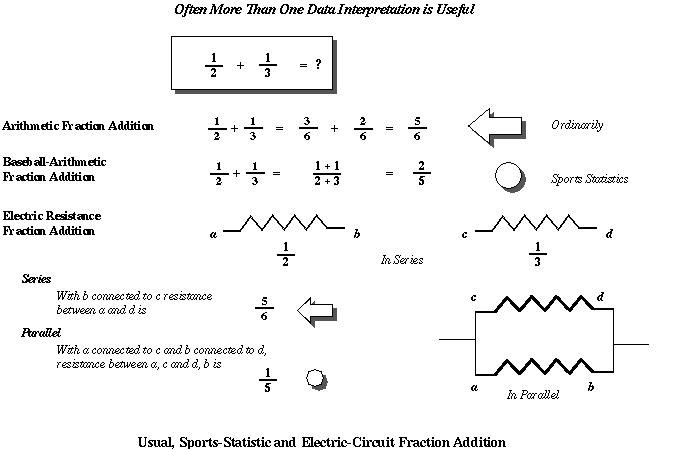
Concepts can be shown. That may be by a single sketch, a series of panels (comic or cartoon style, animated sequence), or a static illustration as in Figure 2. Creativity in mathematical ... or indeed any type of ... problem solving can be supported or inhibited by pictorial means.
Significant differences in reasoning about
a teacup and saucer would follow if they were presented via the left part of
Figure 3 rather than the two distinct entities in the remainder of that
image.

|

|
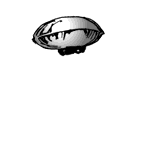
|
Some results from ancient cultures that remain part of our mathematics curriculum can be visually communicated using color animation. For an example we turn to the Pythagorean Theorem. This relationship between the three sides of a right triangle was known in ancient Babylon and Egypt beginning about 1900 B.C., but not widely publicized until Pythagoras. He stated explicitly that for a right angle triangle (i.e., one angle is 90o), the square of the hypotenuse is equal to the sum of the squares of the other two sides:
a2 + b2 = c2 |
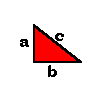
|
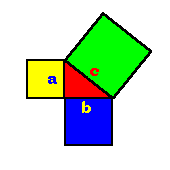
|
The green square has area c2 that equals the sum of two others: exactly the sum of yellow - a2 - and blue - b2 - measurements.
That color animation makes this vividly reasonable for an isoceles triangle special case follows in Figure 5, also by Dorene Lau.. By counting green triangles we quickly see that it is the total of yellow and blue ones.
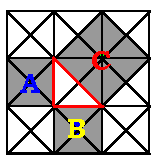
Images of Maori buildings in [1] show beams that are both integral parts of
the structures, and highly decorated in an ordered, mathematical design. Images
from other cultures, ibid. present the rich visual heritage of
people over the world. The analysis in [1] validates the clear perception those
people had of concepts we would associate only with the most esoteric branches
of the mathematical knowledge tree.
Practical Calculation in Arts and Commerce
Few today would pursue the even-handed division practiced in ancient Egypt. Nevertheless, their use of integer fractions has an element of fairness not found in contemporary partitioning schemes. The general subject of partitioning and keeping track of decompositions of quantities is covered in [4].
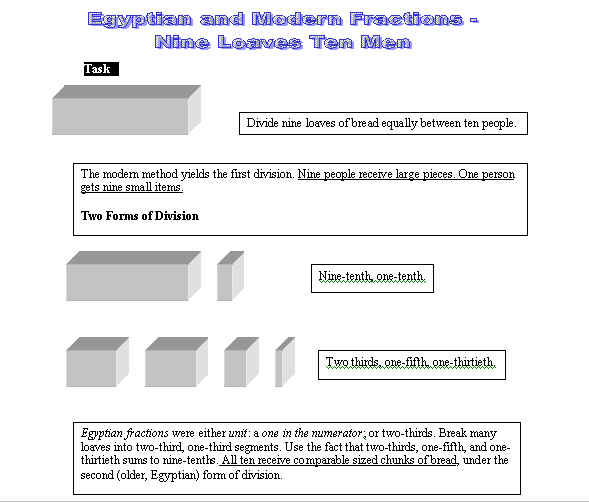 |
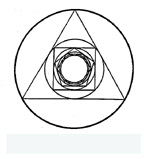 |
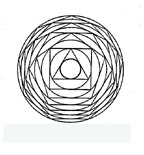 |
Key NameStatusConcernsProperty (Pattern)GoldbachConjectureEven NumbersAlways A Sum of Two PrimesLagrange (Euler)ProvenEvery NumberSum of At Most Four Square NumbersNicomachusProvenEvery CubeSum of Adjacent Odd Numbers |
 |
Some subjects can be used for either of two purposes: encouraging interest in mathematics; or moving toward acquiring some quantitative knowledge needed for success in a practical field. Bases for Counting, below, opens paths to electrical engineering and computer science. Simple statements with three alternative conclusions can be constructed for monitoring progress in subject knowledge acquisition using quizzes based on Figure 8 answers [A.1].
| Symbols for | Number Base | Usable Elements | Each Place's | Sixteenbase |
| Sixteen | Radix System Name | Single Place | Values Powers of Radix | Written |
| ||||| ||||| ||||| | | Sixteen Hexadecimal | 0 1 2 3 4 5 6 7 8 9 A B C D E F | [256,257, ...,4095 = 163-1= 212-1], [16, 17,...,255 = 162-1], [0,1,..., 15 = 161-1] 4096, 256, 16, 1 |
10 |
| V ||||| ||||| | | Fifteen | 0 1 2 3 4 5 6 7 8 9 A B C D E | [225,226,...,3374 = 153-1], [15,16,...,224 = 152-1], [0,1,...,14 = 151-1] 3375, 225, 15, 1 |
11 |
| X ||||| | | Fourteen | 0 1 2 3 4 5 6 7 8 9 A B C D | [196,197,...,2743 = 143-1], [14,15,...,195 = 142-1], [0,1,...,13 = 141-1] 2744, 196, 14, 1 |
12 |
| X V I | Thirteen | 0 1 2 3 4 5 6 7 8 9 A B C | [169,170,...,2196 = 133-1], [13,14,...,168 = 132-1], [0,1,...,12 = 131-1] 2197, 169, 13, 1 |
13 |
| XVI £ | Twelve Duodecimal | 0 1 2 3 4 5 6 7 8 9 X L | [144,145,...,1727 = 123-1], [12,13,...,143 = 122-1], [0,1,...,11 = 121-1] 1728, 144, 12, 1 |
14 |
| XVI ¢ | Eleven | 0 1 2 3 4 5 6 7 8 9 X | [121,122,...,1330 = 113-1], [11,12,...,120 = 112-1], [0,1,...,10 = 111-1] 1331, 121, 11, 1 |
15 |
| XVI ¥ | Ten Decimal | 0 1 2 3 4 5 6 7 8 9 | [100,101,...,999 = 103-1], [10,11,...,99 = 102-1], [0,1,...,9 = 101-1] 1000, 100, 10, 1 |
16 |
| ||||| ||||| ||||| | | Nine | 0 1 2 3 4 5 6 7 8 | [81,82,...,728 = 93-1], [9,10,...,80 = 92-1], [0,1,...,8 = 91-1] 729, 81, 9, 1 | 17 |
| 16 dollars | Eight Octal | 0 1 2 3 4 5 6 7 | [64,65,...,511 = 83-1], [8,9,...,63 = 82-1], [0,1,...,7 = 81-1] 512, 64, 8, 1 | 20 |
| $ 16 | Seven | 0 1 2 3 4 5 6 | [49,50,...,342 = 73-1], [7,8,...,48 = 72-1], [0,1,...,6 = 71-1] 343, 49, 7, 1 | 22 |
| 16 pounds | Six | 0 1 2 3 4 5 | [36,37,...,215 = 63-1], [6,7,...,35 = 62-1], [0,1,...,5 = 61-1] 216, 36, 6, 1 | 24 |
| £ 16 | Five | 0 1 2 3 4 | [25,26,...,124 = 53-1], [5,6,...,24 = 52-1], [0,1,...,4 = 51-1] 125, 25, 5, 1 | 31 |
| ¥ 16 | Four Quaternary | 0 1 2 3 | [16,17,...,63 = 43-1], [4,5,...,15 = 42-1], [0,1,...,3 = 41-1] 64, 16, 4, 1 | 100 |
| 16 yen | Three Ternary | 0 1 2 | [9,10,...,26 = 33-1], [3,4,...,8 = 32-1], [0,1,2 = 31-1] 27, 9, 3, 1 | 121 |
| ||||| ||||| ||||| | | Two Binary | 0 1 | [8,9,..., 15 = 24-1], [4,5,6,7 = 23-1], [2,3 = 22-1], [0,1 = 21-1] 8, 4, 2, 1 | 10000 |
 |  |
 |